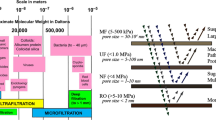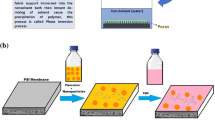Abstract
Nanofiltration (NF) is a pressure driven membrane process applied in the area between the separation capabilities of reverse osmosis (RO) membranes and ultrafiltration (UF) membranes, that is, in the separation of ions from solutes such as small molecules of sugars. Nanofiltration is often used where the divalent ions (Ca, Mg and ions of plating industry) have to be removed. The molecular weight cut off of nanofiltration membranes is between 200-1000 Daltons, which means pore size ranges between 1-10 nm. Typical rejections of NF membranes are 60% for NaCl, 98% for magnesium sulphate, glucose and sucrose. Generally, this opens up the possibilities for process efficiency improvements and the production of new products, particularly in the food industry and biotechnology1. Some other specific applications are removal of colour, removal of TOC and trihalomethane precursors from surface water, removal of low molecular weight species such as organics in pharmaceutical production, surfactants from waste waters. The potential applications of nanofiltration in food industry and environmental protection are listed in Tab. 1.
Access this chapter
Tax calculation will be finalised at checkout
Purchases are for personal use only
Preview
Unable to display preview. Download preview PDF.
Similar content being viewed by others
References
Scott, K., 1995, Handbook of Industrial Membranes, Elsevier, Oxford, pp. 46, pp.726–770
Mulder, M., 1996, Basic Principles ofMembrane Technology, Kluwer Academic Publishers, Dordrecht, pp. 297–303
Mallevialle, J., Odendaal, P.E., Wiesner, M.R. (Eds), 1996, Water Treatment Membrane Processes, Mc Graw-Hill, New York, pp. 9.1–9.70
Matamoros, H., Cabassud, C., Aurelle, Y., 1996, Nanofiltration Processes for Cutting Oil Wastewater Treatment, Proceedings of 7 th World Filtration Congress, Budapest, Hungary, pp. 531–535
Bender, R, Pflanzel, A., Czermak, P., Vienken, J., 1999, Endotoxin - Rückhalt mit keramischen Membranen, Preprints of 7. Aachener Membrane Kolloqium, Aachen, Germany, pp. 237–240
Weber, R., Chmiel, H, Fischer, G., Voigt, I., 1999, Keramische TiO2 — Nanofiltrationsmembranen fur den Einsatz in der Abwassertechnik, Preprints of 7. Aachener Membrane Kolloqium, Aachen, Germany, pp. 241–244
Wunsch, M., Nagel, R., Schick, W., 1999, Betriebsehrfahrangen mit der Nanofiltration bei der Trinkwasserenthärtung, Preprints of 7. Aachener Membrane Kolloqium, Aachen, Germany, pp. 245–248
Raff, O., Wilken, R.D., 1999, Versuche zur Uranentfemung aus Trinkwasser durch Nanofiltration, Preprints of 7. Aachener Membrane Kolloqium, Aachen, Germany, pp. 253–256
J.P. van’t Hul, Rácz, I.G., Reith, T., 1999, The Treatment of Waste Water from Washing processes Subsequent to Textile Reactive Dyeing Processes by Reverse Osmosis and Nanofiltration, Preprints of 7. Aachener Membrane Kolloqium, Aachen, Germany, pp. 257–261
Kirmess, S., Brand, Ch., Mirza, S., 1999, Erfahrungen mit laugenbestandigen organischen Nanofiltrationsmembranen, Preprints of 7. Aachener Membrane Kolloqium, Aachen, Germany, pp. 263–266
Goers, B., Mey, J., Wozny, G., 1999, Optimization of the Product and Water Recovery for Batch-Treatment of Rinsing Waters with Changing Composition, Proceedings of PRESS’99–2 nd Conference on Process Integration, Modelling and Optimisation for Energy Saving and Pollution Reduction, Budapest, Hungary, pp. 299–304
Radier, G.G.J., Van Oers, C.W., Wessling, M., 1999, Purification of Cooling Water at a Plant of Methanor with Nanofiltration, Euromembrane’99, Leuven, Belgium, Book of Abstracts, Vol. 1., pp. 130
Author information
Authors and Affiliations
Editor information
Editors and Affiliations
Rights and permissions
Copyright information
© 2000 Springer Science+Business Media New York
About this chapter
Cite this chapter
Vatai, G. (2000). Nanofiltration application in food technology and environmental protection. In: Bélafi-Bakó, K., Gubicza, L., Mulder, M. (eds) Integration of Membrane Processes into Bioconversions. Springer, Boston, MA. https://doi.org/10.1007/978-1-4615-4269-8_11
Download citation
DOI: https://doi.org/10.1007/978-1-4615-4269-8_11
Publisher Name: Springer, Boston, MA
Print ISBN: 978-1-4613-6917-2
Online ISBN: 978-1-4615-4269-8
eBook Packages: Springer Book Archive




